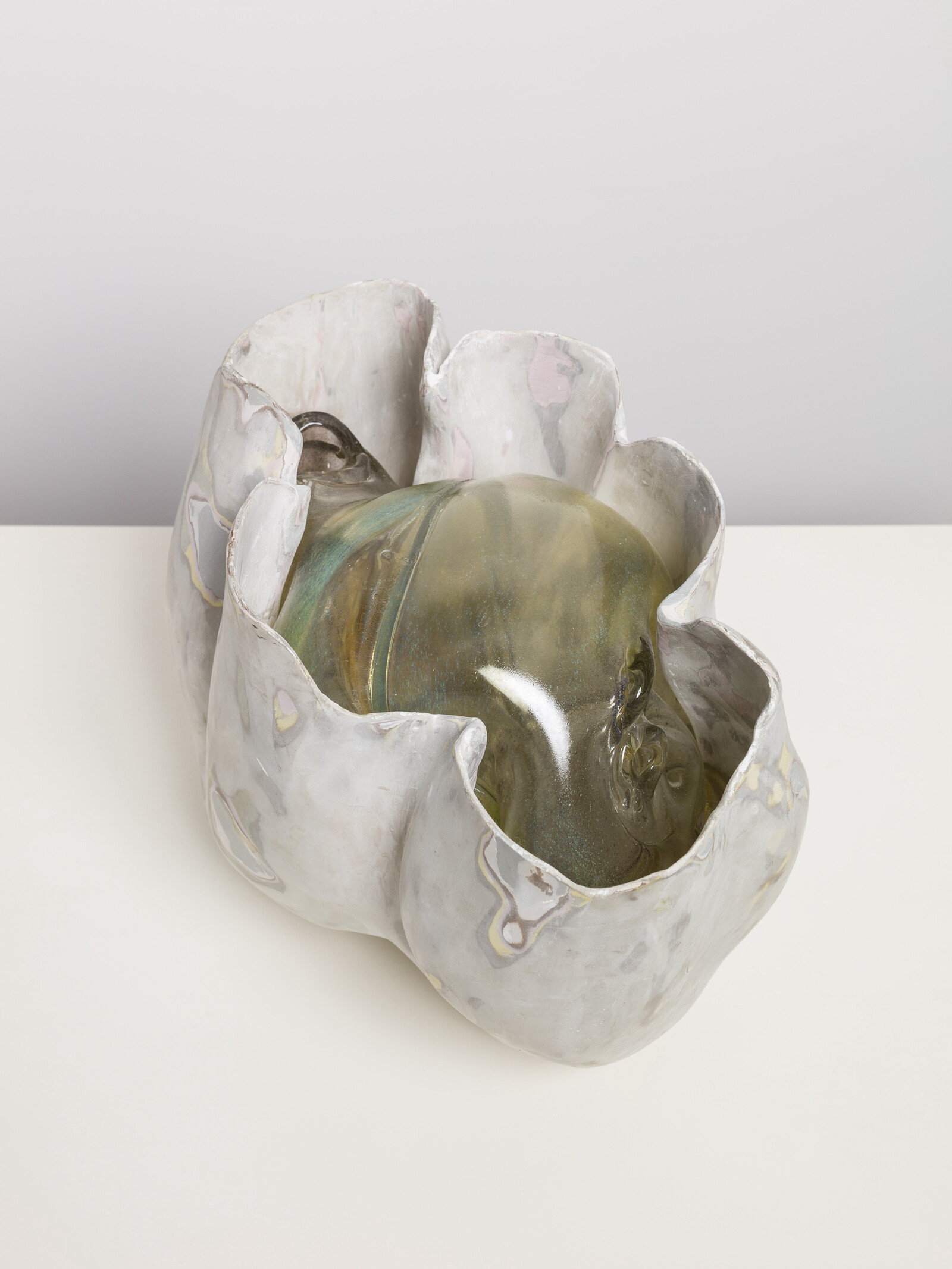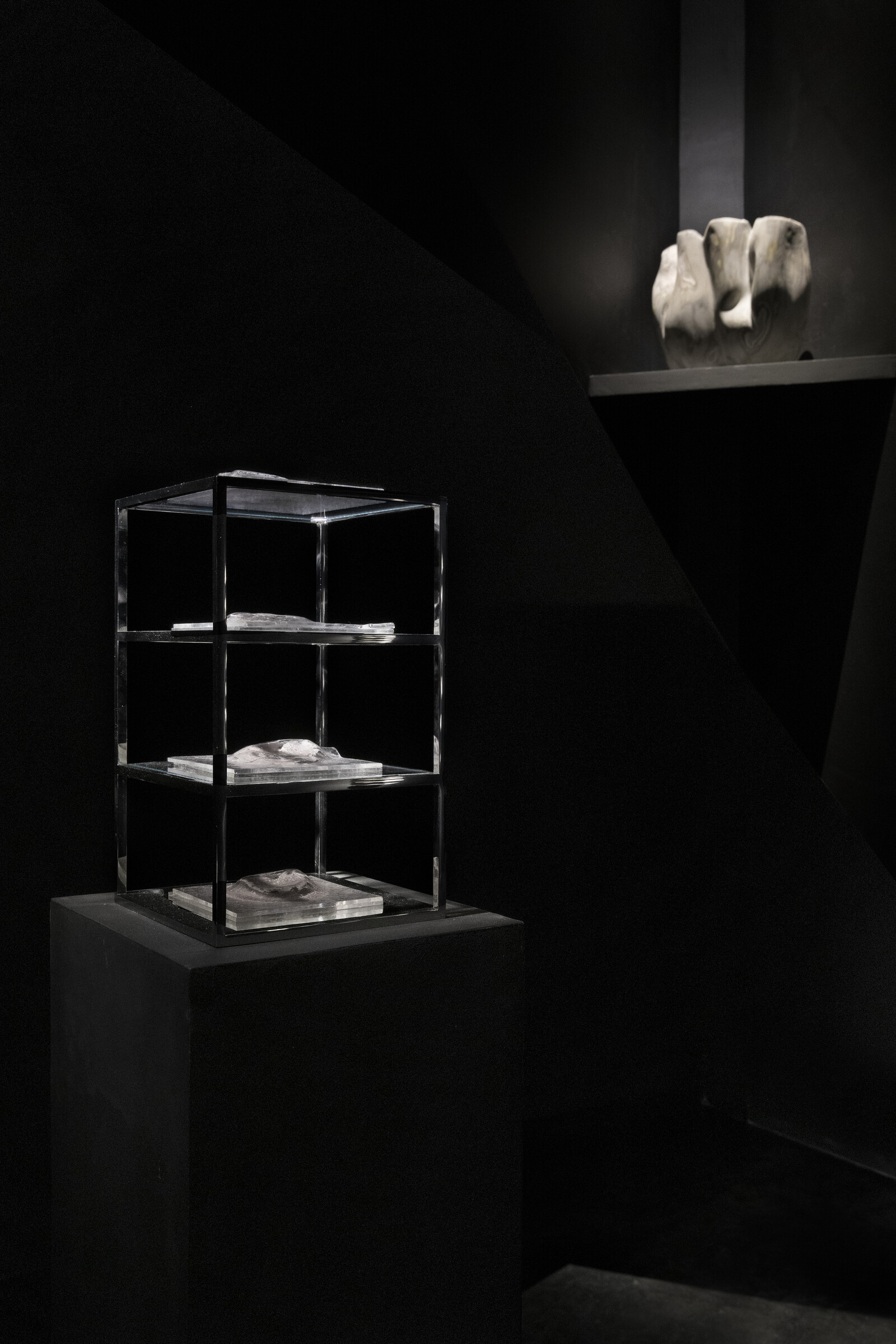In one corner of Jes Fan’s latest exhibition is a glass globe that fits snugly into a receptacle resembling a half-opened, upright clam’s shell. Titled Left and right knee, grafted (all works 2023) and installed on a ledge in the curve of the staircase that leads down into the gallery, the sculpture’s treasure is only visible from above; from below, only its undulating, opal façade can be seen. The body parts and procedure referenced in the artwork’s title are hardly, if at all, discernible in the artwork’s form; an obtuseness compounded by its relatively inaccessible position in the exhibition space. Like the “pearl” it protects, this artwork reveals its meaning only in glimpses.
Indeed, even the exhibition’s figurative sources are hidden in plain sight: all of these seemingly abstract sculptures are cast from knees, chests, and torsos. Arranged in a vertical line, Left and right knees, three times is composed of six wall-mounted aqua resin basins, each approximately the same size and shape and spaced evenly apart. Despite the mathematical connotations of its title, the sculpture resembles an outlandish cascading fountain adorned with esoteric insignia. Fan mimicked an oyster shell’s palette by sanding various pigments—yellows, pinks, browns, and blues—onto aqua resin surfaces. Oysters are the first subject in Fan’s iterative artistic project on regeneration in sites of injury.
Other works, like Left torso, four times, a quartet of jellyfish-like steel and aqua resin constructions, also bear the artist’s trademark psychedelic blooms. Closer inspection reveals, however, that the sculpture’s seduction is superficial: the proverbial fountain has dried up, save for small urine-colored puddles—pigmented glass shards that have been melted down and left over in each vessel. The artwork’s repeated bodily constitutions yield only variations on excretory emptiness. That the artist has intentionally obfuscated the physiognomic accuracy and origin of these indexed body parts is noteworthy, given the objectifying and reductive appraisal of artists, like Fan, who identify as trans.
The glass form ensconced within Left and right knee, grafted is split down the middle. A trained glassmaker, Fan created the effect by inserting two blowpipes into a single goblet during the glass-blowing process, bifurcating the glass and creating a pair of ventricular chambers. The artist complemented these traditional techniques with the use of digital software to model and augment the only floor-based works in the exhibition, Bivalve I and II. Held just a few inches above the floor by complex steel armatures, their patterned carapaces conceal glass components which—as in the case of Left and right knee, grafted—can only be seen from awkward angles. While Fan’s previous glass sculptures suspended bodily substances such as hormones and skin pigments, these shells reveal only transparent and empty glass spheres. The question of why Fan goes to such lengths to obscure them is addressed by the five-minute video Palimpsest.
Accompanied by a wordless, ASMR-like soundtrack and panoramic views of the Hong Kong harbor, lyrical subtitles narrate Fan’s nearly three-year research, alongside scientists from the University of Hong Kong, into native oyster species. Intrigued by the process of pearl formation, during which oysters secrete lustrous nacre over foreign objects, Fan experimented with implanting four Chinese characters spelling out Hong Kong’s moniker, Pearl of the Orient, into four live oysters. He later sandwiched the oysters between two plates of glass before firing them in a kiln. C is for you is a tiered, stainless-steel display of these charred glass plates, sans oysters and letters. Here as elsewhere in the exhibition, the artefact of that process is an absence.
Understood collectively, these studies in physical reconstruction and withheld information might be understood as Fan’s response to our society’s tendency to sensationalize bodily fetish and harm, especially when it comes to gender and sexual embodiment. Like the oysters in Palimpsest—which consume, write over, and aestheticize an essentialist identity—the mesmerizing veneers of the exhibited artworks double as disguises, frustrating those viewers who expect trauma or revelation from art.






